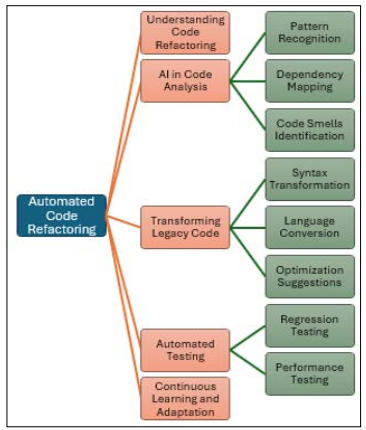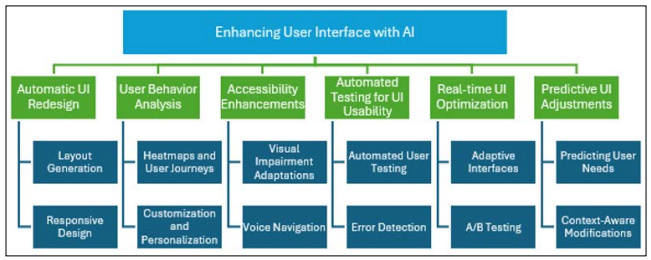Transforming Digital Landscapes: Leveraging AI to Modernize Legacy Web Applications
Author(s): Vijayasekhar Duvvur
Abstract
The modernization of legacy web applications is a critical challenge for many organizations striving to maintain competitive advantage in a rapidly evolving digital landscape. Artificial Intelligence (AI) offers a transformative potential for automating and enhancing the modernization process. This article explores the utilization of AI technologies to streamline the transition of outdated systems to contemporary, agile platforms. By integrating AI, organizations can improve the accuracy of code conversion, optimize performance, and predict system behaviors, ultimately reducing costs and accelerating deployment times.
Introduction
Legacy web applications often constitute a significant portion of an organization’s critical operations. However, these systems can hinder agility due to outdated technologies, inflexible architectures, and compatibility issues with new software or hardware. Modernizing these applications by leveraging AI not only enhances their operational efficiency but also integrates advanced analytical capabilities and improved user experiences. This article delves into how AI can aid in various phases of the modernization process, from initial assessment through to deployment and ongoing optimization.
The Role of AI in Legacy Modernization
AI plays a transformative role in legacy system modernization by automating complex processes such as data migration, code refactoring, and system testing. AI enhances data integrity through advanced error detection and correction mechanisms, reducing manual oversight and potential errors. Additionally, AI technologies facilitate predictive maintenance and performance optimization, ensuring legacy systems are efficiently upgraded to meet current technological standards. Through these capabilities, AI significantly streamlines the modernization process, reducing costs and improving system reliability and functionality. Let us dive deep into the role of AI in legacy modernization:
Initial Assessment and Planning
AI-driven tools can automate the initial assessment of legacy systems, which is typically labor-intensive. Using techniques such as Natural Language Processing (NLP) and machine learning algorithms, these tools can analyze existing codebases to identify dependencies, document APIs, and understand database schemas. This automated analysis helps in planning the modernization process by:
- Identifying components for reuse or refurbishment.
- Highlighting problematic areas of the code that require significant rework or
- Estimating the effort and resources needed for the project [1].
Automated Code Refactoring
Automated code refactoring using Artificial Intelligence (AI) represents a significant leap forward in the modernization of legacy web applications. This process involves the application of machine learning algorithms and other AI techniques to analyze, optimize, and transform old code bases into more modern, efficient, and maintainable forms. Here’s a deeper look into how AI facilitates automated code refactoring:

Figure 1: Automated Code Refactoring process
Understanding Code Refactoring
Code refactoring is the process of restructuring existing computer code-changing the factoring-without changing its external behavior. Its primary goals are to improve the design, structure, and/or implementation of software, while preserving its functionality. Refactoring helps keep the code base clean and adaptable, which is crucial for ongoing maintenance and future development [2].
AI in Code Analysis
AI-driven tools begin the refactoring process by conducting a thorough analysis of the legacy code base. This involves:
- Pattern Recognition: AI models trained in code pattern recognition can identify complex code patterns, anomalies, and inefficiencies that might not be evident even to experienced
- Dependency Mapping: AI algorithms analyze and document the dependencies within the code, helping to understand how different modules interact. This mapping is crucial when determining the impact of changes made during the refactoring process.
- Code Smells Identification: “Code smells” are characteristics of software that indicate potential AI tools can detect these smells, such as duplicated code, overly complex methods, or improper abstraction, which are prime candidates for refactoring.
Transforming Legacy Code
Once the initial analysis is complete, AI tools can automate the transformation of legacy code to modern standards. This involves:
- Syntax Transformation: AI can automatically convert old syntax to new ones, adapting legacy code to modern programming standards and For example, converting an old PHP code base to use PHP 7+ features, or adapting old Java applications to align with Java SE 14.
- Language Conversion: In some cases, it may be beneficial to convert legacy applications written in outdated or less efficient languages to more contemporary and performant AI can help automate this conversion, for example, translating a Visual Basic application to C# or Python.
- Optimization Suggestions: Based on the analysis, AI can suggest and implement optimizations, such as consolidating duplicate code blocks, simplifying complex expressions, and enhancing algorithm
Automated Testing
AI-driven refactoring tools typically integrate automated testing to verify that changes do not alter the intended functionality:
- Regression Testing: Automated tests are run to ensure that the refactored code behaves as expected. AI can generate and execute these tests, comparing pre- and post-refactoring outputs to detect any discrepancies.
- Performance Testing: AI tools can simulate different usage scenarios to test the performance of the refactored code under various conditions, ensuring that the software maintains or improves its performance post-refactoring.
Continuous Learning and Adaptation
AI systems involved in code refactoring are often designed to learn continuously from their operations. They use data from each refactoring project to improve their algorithms, making them more efficient and effective over time. This continuous improvement cycle helps in handling increasingly complex refactoring tasks with higher accuracy
Enhancing User Interface with AI
The modernization of legacy web applications often involves significant updates to the user interface (UI) to meet contemporary usability standards and expectations. Artificial Intelligence (AI) plays a pivotal role in transforming these interfaces by automating design processes, personalizing user experiences, and ensuring that new UIs are both functional and appealing. Below is a detailed examination of how AI can enhance the UI during the modernization of legacy systems [3].

Figure 2: Enhancing User Interface with AI
Automatic UI Redesign
AI can significantly streamline the redesign of user interfaces by automating several elements of the design process:
- Layout Generation: AI algorithms can analyze user interaction data from existing systems to generate UI layouts that are optimized for usability and accessibility. Tools like Adobe’s Sensei use AI to suggest design elements based on best practices and user behaviors [4].
- Responsive Design: AI can ensure that the new UI is responsive and adapts seamlessly across different devices and screen sizes, enhancing the user experience. AI-driven tools can automatically adjust UI components for optimal viewing on tablets, smartphones, and desktops [5].
User Behavior Analysis
By leveraging data analytics and machine learning, AI can analyze how users interact with the application, identifying patterns that may not be apparent through conventional analysis:
- Heatmaps and User Journeys: AI tools can generate heatmaps that show where users click most frequently and track user journeys through the This information is crucial for designing interfaces that are intuitive and reduce user friction.
- Customization and Personalization: AI algorithms can personalize user experiences by adapting interfaces based on individual user preferences and This can include dynamic changes to layouts, navigation, and even functionalities, depending on the user’s role, previous actions, or preferences.
Accessibility Enhancements
AI can help ensure that modernized applications are accessible to all users, including those with disabilities:
- Visual Impairment Adaptations: AI-driven tools can adjust color schemes and font sizes in real-time based on user preferences or needs and can even interpret visual elements for screen readers [6].
- Voice Navigation: Integrating AI with natural language processing capabilities allows for voice-activated navigation and control, making the application more accessible to users with physical disabilities.
Automated Testing for UI Usability
AI can automate the testing of UI elements for usability and functionality:
- Automated User Testing: Tools powered by AI can simulate user interactions to test the usability of different UI elements [7]. These tools can provide feedback on how intuitive the UI is and suggest
- Error Detection: AI can be employed to detect and report UI errors, such as broken links, unresponsive buttons, or alignment issues, ensuring that the final interface is polished and professional.
Real-time UI Optimization
Using AI, the UI can be optimized in real-time based on ongoing user interactions and feedback:
- Adaptive Interfaces: AI can modify the UI dynamically in response to user interactions. If certain features are frequently used, they can be made more prominent, or if users struggle with a particular aspect of the interface, it can be simplified [3,8].
- A/B Testing: AI can manage A/B testing campaigns by automatically adjusting elements of the UI and measuring performance to determine which variations deliver the best user experience.
Predictive UI Adjustments
AI’s predictive capabilities allow it to forecast future user actions and adjust the UI preemptively to enhance user experience:
- Predicting User Needs: Based on past interactions, AI can predict what information or functionality a user might need next and adjust the UI to make these elements easily accessible [9].
- Context-Aware Modifications: Depending on the time of day, location, or user activity, AI can modify the UI to better suit the context of use, enhancing the overall usability and effectiveness of the application.
Predictive Performance Optimization
AI technologies enable predictive analytics to forecast how proposed changes will affect application performance. This includes:
- Using simulation models to predict the impact of new features or increased load on application performance.
- AI-driven monitoring tools that continuously learn from the system’s performance data to identify patterns and predict future bottlenecks, allowing preemptive optimization.
Automated Testing and Quality Assurance
AI enhances testing processes by automating test case generation and identifying potential test scenarios based on the change impact analysis. This reduces human error and increases the coverage and accuracy of testing, which is crucial for ensuring the quality of the modernized application [7].
Conclusion
Leveraging AI in the modernization of legacy web applications provides a robust framework for transforming outdated systems into modern, efficient, and scalable platforms. AI accelerates every phase of the modernization process, from initial assessment to deployment, ensuring that the transition is not only successful but also cost-effective and timely. By adopting AI, organizations can future-proof their applications and prepare them to meet evolving business needs and technology standards
References
- Cuomo J, Akkiraju R, Chan A, Davis H, Glasman E, et al. (2022) The Art of Automation: Discover how AI-powered automation helps people reclaim up to 50% of their time at Kindle https://www.amazon.in/Art-Automation- Discover-AI-powered-automation-ebook/dp/B09T94X9Y1.
- Singh A, Singh P (2023) Leveraging Artificial Intelligence and Machine Learning in Software Engineering: Current Trends and Future Directions. International Research Journal of Modernization in Engineering Technology and Science 5: 7048-7062.
- Gerhard Fischer (2023) Adaptive and Adaptable Systems: Differentiating and Integrating AI and EUD. International Symposium on End User Development 3-18.
- Bozic V (2023) Application of artificial intelligence in user interface Research Gate https:// www.researchgate.net/profile/ Velibor-Bozic-2/ publication/370051038_APPLICATION_OF_ARTIFICIAL_ INTELLIGENCE_IN_USER_INTERFACE_DESIGN/ links/65673b0bce88b870311f7487/APPLICATION-OF- ARTIFICIAL-INTELLIGENCE-IN-USER-INTERFACE- DESIGN.pdf.
- Tosic D (2023) Artificial Intelligence-driven web development and agile project management using OpenAI API and GPT technology: A detailed report on technical integration and implementation of GPT models in CMS with API and agile web development for quality user-centered AI chat service Digital Scientific Archive https://www.diva- portal.org/smash/record.jsf?pid=diva2%3A1764392&dsw id=3715.
- Chia En Tseng, Seoung Ho Jung, Yasmine N Elglaly, Yudong Liu, Stephanie Ann Ludi (2022) Exploration on Integrating Accessibility into an AI SIGCSE 2022: Proceedings of the 53rd ACM Technical Symposium on Computer Science Education 864-870.
- Pham P, Nguyen V, Nguyen T (2023) A Review of AI- augmented End-to-End Test Automation Tools. ASE ‘22: Proceedings of the 37th IEEE/ACM International Conference on Automated Software Engineering 1-4.
- Kolthoff K (2019) Automatic Generation of Graphical User Interface Prototypes from Unrestricted Natural Language 34th IEEE/ACM International Conference on Automated Software Engineering (ASE) https://ieeexplore. ieee.org/abstract/document/8952477/authors#authors.
- Samanpour AR, Ruegenberg A, Ahlers R (2017) The Future of Machine Learning and Predictive Digital Marketplaces Unleashed 297-309.
View PDF


